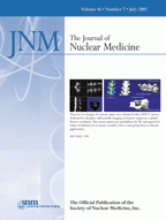OtherClinical Investigations
Assessment of Diastolic Function Using 16-Frame 99mTc-Sestamibi Gated Myocardial Perfusion SPECT: Normal Values
Cigdem Akincioglu, Daniel S. Berman, Hidetaka Nishina, Paul B. Kavanagh, Piotr J. Slomka, Aiden Abidov, Sean Hayes, John D. Friedman and Guido Germano
Journal of Nuclear Medicine July 2005, 46 (7) 1102-1108;
Cigdem Akincioglu
Daniel S. Berman
Hidetaka Nishina
Paul B. Kavanagh
Piotr J. Slomka
Aiden Abidov
Sean Hayes
John D. Friedman
In this issue
Journal of Nuclear Medicine
Vol. 46, Issue 7
July 1, 2005
Assessment of Diastolic Function Using 16-Frame 99mTc-Sestamibi Gated Myocardial Perfusion SPECT: Normal Values
Cigdem Akincioglu, Daniel S. Berman, Hidetaka Nishina, Paul B. Kavanagh, Piotr J. Slomka, Aiden Abidov, Sean Hayes, John D. Friedman, Guido Germano
Journal of Nuclear Medicine Jul 2005, 46 (7) 1102-1108;
Assessment of Diastolic Function Using 16-Frame 99mTc-Sestamibi Gated Myocardial Perfusion SPECT: Normal Values
Cigdem Akincioglu, Daniel S. Berman, Hidetaka Nishina, Paul B. Kavanagh, Piotr J. Slomka, Aiden Abidov, Sean Hayes, John D. Friedman, Guido Germano
Journal of Nuclear Medicine Jul 2005, 46 (7) 1102-1108;
Jump to section
Related Articles
Cited By...
- Quantitative Clinical Nuclear Cardiology, Part 1: Established Applications
- Presence of Postsystolic Shortening Increases the Likelihood of Coronary Artery Disease: A Rest Electrocardiography-Gated Myocardial Perfusion SPECT Study
- Automated Segmentation of Routine Clinical Cardiac Magnetic Resonance Imaging for Assessment of Left Ventricular Diastolic Dysfunction
- Automatic Global and Regional Phase Analysis from Gated Myocardial Perfusion SPECT Imaging: Application to the Characterization of Ventricular Contraction in Patients with Left Bundle Branch Block
- Diastolic Filling Parameters Derived from Myocardial Perfusion Imaging Can Predict Left Ventricular End-Diastolic Pressure at Subsequent Cardiac Catheterization







